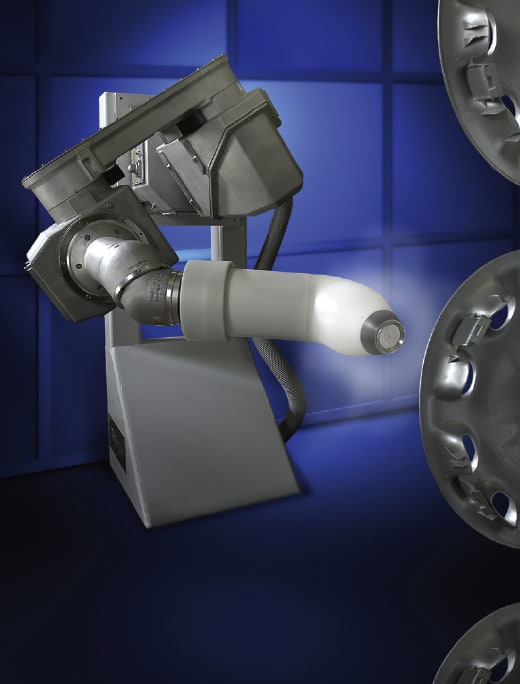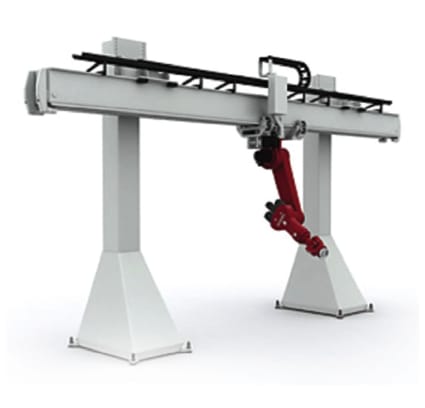Robotics technology has made measurable strides in the last few years. Today’s robots can move with greater precision over a more flexible range of motion, while handling heavier payloads. Advances in vision systems and software are giving robots the ability to recognize and handle a wider range of parts than before, and make decisions that only humans could previously perform.

Advances in robot technology stem, in part, from the demands placed in applications such as aerospace. For instance, Gudel Inc. (Ann Arbor, MI), has developed a flexible, lightweight robot platform, called roboFlex, to meet tight tolerance requirements in aircraft manufacturing and other precision applications.
RoboFlex consists of a 5-axes robot arm which is fitted in a suspended position on a linear traveling axis. roboFlex makes it possible to position workpiece grippers and operating heads in any axis direction and angle required. The small mass guarantees very high dynamics and maximum rigidity and accuracy.
“The aerospace industry is drastically changing the way they manufacture aircraft and the materials being used,” said Dale Cozart, product manager of aerospace. “The suppliers must meet these challenges with advances in new technology of their own. New materials require new manufacturing processes and outside the box thinking.”
Ted Wodoslawskyl, vice president of marketing for the Robotics Division of ABB Inc. (Auburn Hills, MI), added, “There is a lot of activity in aerospace and also in solar panel manufacturing. In solar panels, robots are being used to handle solar cells during manufacturing and also soldering the individual cells into solar panels.”
Food processing and biomedical represent two emerging robot applications, according to Claude Dinsmoor, general manager of controller product development for Fanuc Robotics America Inc. (Rochester Hills, MI). “High-speed food processing with visual line tracking used to require lots of time with custom manufacturing equipment. Now, robots equipped with high-speed vision systems can do the work.”
Painting is another task now done largely with robots, Dinsmoor added. “Historically, because of automotive, robots are used for painting. In the U.S., almost all painting is done with robots.”
Aerospace is also moving rapidly to automated robotic painting, particularly for critical or high-performance coatings, noted Kirk McLauchlin, president of AeroBotics (Huntsville, AL), a robotic systems integrator. “Robots reduce preparation work, as you don’t have to premark and mask areas, and they also reduce rework.”
Jerry Perez, account manager for paintshop automation at FANUC Robotics Toledo, added that automated robotic painting makes it possible to program camouflage patterns off-line, and deal with variation in vehicles.
Robot manufacturers attribute recent advances largely to software improvements that have given robots more flexible motion capability and intelligence. Lloyd Spencer, chief executive for CoroWare Inc. (Redmond, WA), which develops software solutions for robotics applications, said early software algorithms controlling robots were “no more sophisticated than a set of wheels controlling a radiofrequency controlled toy car.” But Spencer added, “The incorporation of Linux and Window-based platforms now means you can run more complex apps that take advantage of layers of software.”
Early on, robots were programmed to perform repetitive tasks generally involving being taught, for example, to recognize a part with a specific size and shape, pick up that part, and move and place it on an assembly or reject it. Now, advanced software algorithms are giving robots the ability to sense and feel the parts they’re handling, noted ABB’s Ted Wodoslawskyl.

SmartTCP Inc.(Farmington Hills, MI) has developed a robotic welding system that relies on hardware and complex software to automate small batch welding applications. “The way the market does it is to teach the robot to search for specific parts in certain instances,” said Effi Lebel, founder and CEO. “We developed searching technology that is good for any part, with any geometry, in any position.”
SmartTCP’S software analyzes the 3D CAD file of a structure’s final assembly drawing as though it were through the eyes of an expert welder. It will then implement the most sophisticated welding and robot technologies. “Because we have a 3D model of the part, we have a virtual image of the part. We can immediately recognize the part and implement the right type of search.”
Advanced vision systems have raised the level of robot intelligence, particularly as manufacturers integrate them with the robot rather than design separate systems. “With latest controllers, we’ve been able to move machine vision processing into the same CPU as the robot,” said Fanuc’s Dinsmoor. “Every robot can now incorporate a camera and cable to implement machine vision. Every robot can now see without the addition of costly equipment.”
ABB’s vision capability enables the robot to see in three dimensions, using a single camera. “In the past, multiple cameras or a camera and a laser were required to locate an object,” said Wodoslawskyl. ABB teams the single camera with highly sophisticated software to find, pick up, and manipulate objects. This approach reduces the robot’s susceptibility to jars and jolts typical in a manufacturing environment, and speeds system calibration.
According to Wodoslawskl, automotive companies are using vision technology to assemble automotive engine heads onto the engine block. “Because the system can find the engine and retrieve it, then pick it up and precisely place it on the engine block, a process that was once manual is now automated. This reduces the change of damage to the head and the engine block, and removes a backbreaking task for the auto worker.”
Robot vision systems now also can compensate for lighting variations in industrial environments. “Ten to 15 years ago, a robot could find a part on a conveyor only with appropriate lighting,” according to Bob Rochelle, North American sales manager for Kawasaki Robotics (USA) Inc. (Wixom, MI).
Improvements in electromechanical components are also enabling robots to handle higher payloads. “Maximum payloads used to be around 200 kilograms, now they’re 500 to 750 kilograms,” said Rochelle. He added that Kawasaki’s robots are used by automotive manufacturers to lift entire car bodies weighing 800 to 900 lb.
To speed productivity, robots are also incorporating flexible tooling that eliminates the need to stop the robot to initiate a new assembly sequence. “As the part comes in, one can switch the system and the robots and tools move,” added Rochelle. “The tooling is adjustable, with the actuator sliding left and right.”
Future Developments
As robots become more intelligent, they will incorporate some of the safety provisions previously implemented on assembly lines, according to Fanuc’s Dinsmoor. These provisions ensure the robot works within the programmed range of movements.
“We’ve started to introduce software safety features within the robot - particularly for ones with larger reach. People want to keep down the work cell size if possible, so we’re implementing functions within software to constrain the robot.”
CoroWare’s Mandrel added, “We’re definitely seeing more situational awareness. Whereas previously a robotics algorithm was used to control one arm, now it is to control two arms and prevent them from hitting one another. “
Lloyd envisions a future with robotic assembly cells comprising multiple, smaller robots working together. “There will be layers of decision making and connections,” Lloyd said. “You can have balanced workloads, with different processors handling different (robot) functions.”

